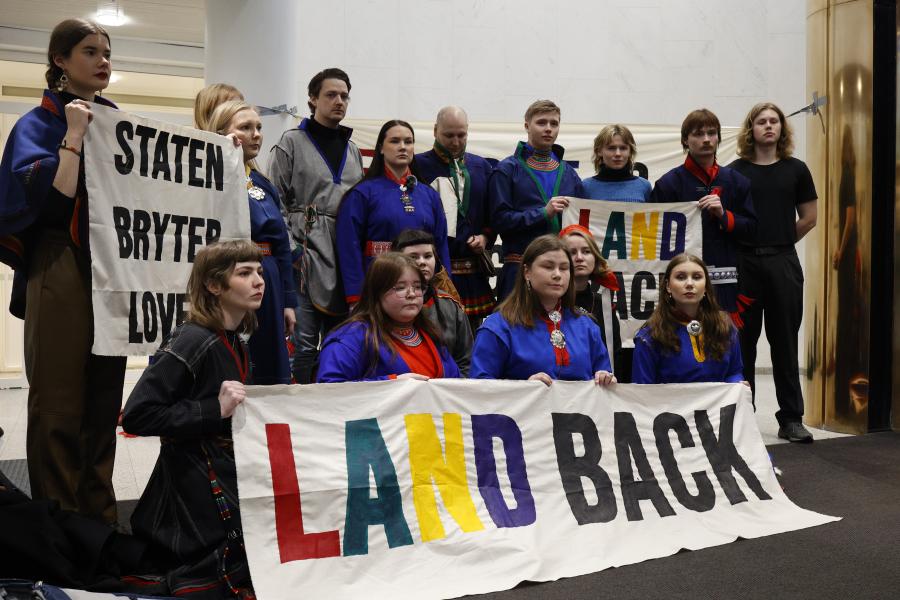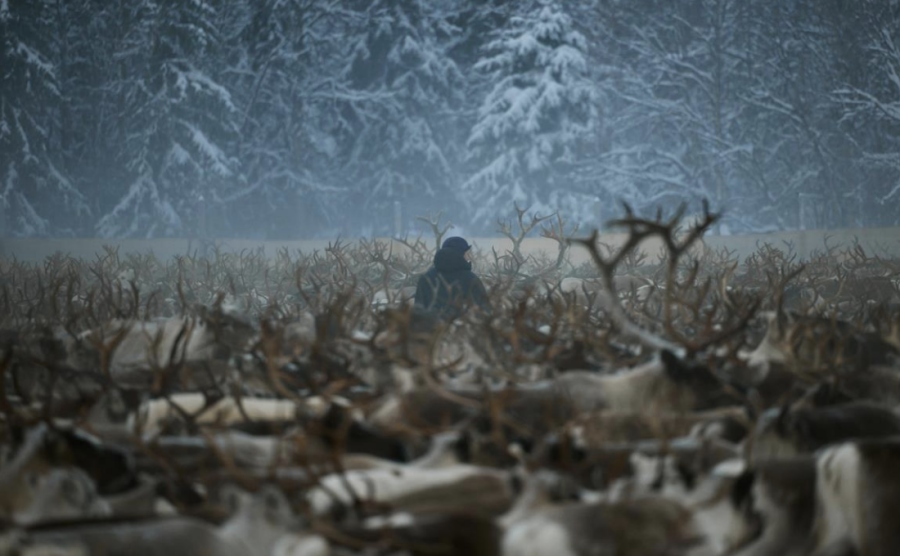In Europe's arctic periphery, one people straddles four nation-states. The traditional tracts of the Saami (formerly called "Lapps") dip south beyond central Norway and Sweden, and skim, across the arctic regions of Finland and the Kola peninsula of the USSR.
Fifty-two thousand persons today call themselves Saami. About 70% speak Saami as well as the national language. As one of Europe's prominent fourth world peoples, Saami constitute roughly 1% of the population of the countries they inhabit. Were there some way to gauge the numbers of Saami who have mixed or otherwise assimilated into the dominant national cultures, these crude population figures would be increased perhaps tenfold.
In prehistoric times nomadic Saami hunters occupied the regions now shared with Norwegians, Swedes, Finns, and Russians. During the past half millennium, many Saami switched from subsistence hunting and gathering to reindeer pastoralism and sedentary agriculture as the expanding fur trade depleted wild animals. Even before this transition, Saami were sporadically deprived of natural resources. Some areas were taxed by as many as four states wishing to establish jurisdiction over the region. Early nationalism of the shifting, overarching hegemonies alternately preyed on and protected the Saami. During some periods, both the language and the culture of the Saami were systematically undermined by government representatives.
Saami peoples first moved north and west into sámieadnan, or Saamiland, the outer reaches of which may have already been occupied. Earlier occupants may have been unrelated to either Saami or Fennoscandians. In response to Fennoscandian colonization pressure and the ethnic assimilation which ensued, areas of Saami settlement gradually receded northward. Nevertheless, the Saami population has steadily increased. Significant numbers of Saami, largely drawn by occupational opportunities in the south and abroad, have outmigrated during this century. More sedentary agriculturalists than nomadic reindeer-breeders, and more women than men outmigrate.
About 10% of Saami are reindeer pastoralists. In some regions there is no pastoralism at all, while in other areas as many as 40% share this livelihood. Nevertheless, reindeer and the mobility associated with pastoralism are powerful symbols of this ethnic group.
Recent factors such as World War II, the welfare state, and fourth world awareness have accelerated and focused change in many arenas. Saami organizations, some dating from early in the century, represent national, occupational, religious, political, and now also ethnic interests. Ethnic activism currently plays a role against the dominant national majority, to a sympathetic but diffuse international audience. To complicate matters, national and ethnic pluralism precludes consensus at the grassroots level which would guide either the indigenous actors or the more sensitive external policymakers, a portion of which are now Saami.
Resource Extraction
The resource needs of nationals in the south were often met on the northern seacoast and tundra. Fish, furs, ores, forests, and now water power and oil, are extracted valuables, necessitating roads, communications systems, and skilled entrepreneurs from outside local communities. The newcomers undertaking these extractive activities are joined by the "foreign" tax collectors, priests, traders, and colonizers already living in the area.
The indigenous form of livelihood most vulnerable to both colonization and resource extraction is reindeer management. Reindeer pasturage and migration routes, all on public lands, are now seriously disturbed by dams, roads, tourism, and military bases. While modern introductions such as electricity and snowmobiles render Saamiland more habitable to non-Saami, these innovations bear costs as well as benefits; many of the introduced elements are environmentally damaging. The once-scattered Saami population has become increasingly clustered in towns with schools, churches, nursing stations, post offices, and stores. When it affects the reindeer-breeding sector, this centralization amounts to sedentarization. A generation ago, herding and husbandry were family activities; today, reindeer management is a commuter industry subsidized by governments promoting meat production rather than the diverse uses traditionally associated with reindeer in Saami culture.
Sedentary Saami have also been affected by assimilation, and by curtailed access to natural resources. Most Saami depend on local firewood, fish, berries, and boot-insulating sedge grass, and all Saami enjoy the harvest of these commodities. It is on collecting forays that the natural historical lore so fundamental to Saami culture is communicated through techniques and chants.
Contemporary Confrontations
Intrusive resource extraction now competes with indigenous needs and wants. Modern substitutes for traditional resources, such as electricity for firewood, often turn out to be irrevocable and costly choices. There have been two particularly significant supreme court cases to focus on Saami rights to "land and water" in their traditional areas. One, the Skattefjäll ("Tax Mountain") case in Sweden, a court-contest lasting for 15 years, concluded in 1981 with a decision unfavorable to the Saami cause. The second, concerning the hydroelectric project scheduled for construction on the Alta-Kautokeino River in Norway, received an unfavorable decision in 1982, after several years in the courts and much dramatic activism on the site and in Oslo itself.
By the time the Alta-Kautokeino hydroelectric project was contested by conservationists and persons involved in ethnic rights, another hundred watercourses had already been regulated in Saami districts. These encroachments most affect those engaged in reindeer management who depend on public lands and routes between seasonal pasturage. The Saami nomad has been a crucial symbol but a very passive participant in national change. For the most part, the nomad is a moving and busy target, leaving practical politics to others. Alta-Kautokeino issues mobilized more reindeer breeders, but also polarized many segments of the population - nomad and sedentary, Saami and Norwegian, northern Norwegian and southern Norwegian.
Collision and Collusion
Despite the interdependence and even intermarriage between nomad and sedentary, and between Saami and Fennoscandian, the reindeer-breeding seasonal nomad has long been the stereotypic Saami. As such, he or she has been envied by other Saami because of the Saami cultural value placed on reindeer and mobility, and has been both admired and feared by the Fennoscandian.
Some persons have speculated whether or not there could be a viable Saami culture without reindeer and pastoralism, just as earlier debates focused on the Saami language. (There is now a resurgence of interest in the Saami language emerging at both the grassroots level and institutional level.) Given the present economic and ecological constraints, one cannot expect a revival of reindeer management in any form. However, persons now practicing reindeer breeding are exceedingly committed to it as a way of life. Many have survived natural and man-made catastrophes.
Some Saami, mostly sedentary agriculturalists, fishers, school teachers, and bureaucrats, feel that the exotic nomad has, in negotiations to date, been overly favored. Ninety percent of the diffuse Saami nation has never been involved in reindeer breeding. Some of these are diligently working on new campaigns to assure general Saami rights and ethnic status, while others assert that dependence on the nation-state and on the global economy is only compatible with a pluralism yet to be forged. Despite the two unfavorable supreme court decisions, concerned persons from all quarters are pursuing these issues through other channels. "Saamiland" is on many tongues as well as maps around the world.
Distribution of Populations in Fennoscandia (in thousands)
Population Norway Sweden Finland USSR All
Total national 3,998 8,043 4,695 500 17.236
Ethnically Saami 30 15 5 2 52
Saami-speakers 22 10 4 1 37
Reindeer-owners 2.5 2.5 1.5 0.5 7
Article copyright Cultural Survival, Inc.


